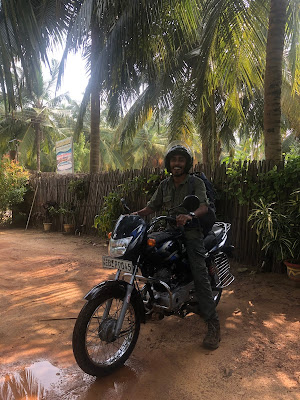 |
| Eurasian Curlew, photo by Saranga. |
We spent the second part of our trip shore birding. As we headed north towards Kalpitiya, we passed several tanks and sections of lagoon that were full of shorebirds and waders. One spot we spent nearly an hour on the side of the road scanning through about 60+ shorebirds. Among them were species we hadn’t yet seen this fall, including Curlew Sandpiper and Black-bellied Plover.
 |
| Common Redshank, photo by Saranga |
 |
| A common sight in any good shorebird habitat, Kentish Plovers, photo by Saranga |
We continued north until we arrived at our hotel. After checking in and cooling off a bit, we headed towards the sand bar separating the sea from the lagoon. Evening birding along the lagoon did not disappoint as we added Whimbrel, Eurasian Curlew, Gray Francolin, Pied Kingfisher, and Indian Paradise-Flycatcher to our trip list. As we were birding, someone on a bicycle rode by selling ice cream, so we enjoyed an ice cream cone as we watched the foraging shorebirds. As the sun set on the sand dunes, we made our way back to the hotel to enjoy the pool before bed.
 |
| Enjoying ice cream while birding |
 |
| Whimbrel, photo by Saranga |
 |
| Indian Paradise-Flycatcher, photo by Saranga |
 |
| Crimson Rose, photo by Saranga |
We set out at first light to walk down the road for some exercise and birding. Broad-billed Sandpiper, a life bird for Saranga, was a highlight of the morning, along with some active Ruddy Turnstones, and better looks at a family of Gray Francolin. I really enjoyed watching the Eurasian Curlew bathing in a puddle.
 |
| Eurasian Curlew, handheld iPhone through Vortex Razor HD |
Once we had sufficiently surveyed the area, we decided to head back out to the sand bar. We were treated to near side-by-side comparisons of the Whimbrel and Eurasian Curlew, and of Black-tailed and Bar-tailed Godwits. We were traveling by bike and stopping to scope and walk around when we saw a promising area, which is a quite enjoyable and effective way of birding!
At one time, we were driving along the lagoon towards a point where a group of terns were roosting. As we drove, I noticed a couple shorebirds with upturned bills. We quickly stopped and got the scope on them and started snapping pictures. I thought they might be Terek Sandpipers and pulled out my field guide to be sure. They were! Another life bird for us both! Terek Sandpipers have an interesting foraging behavior, where they quickly run with their heads down, then stop and listen, then run some more. Their short legs, relative to other shorebirds, make them almost comical to watch run along the water’s edge. Their speed and agility made them difficult to photograph for me, since I was hand-holding my phone to take pictures through my spotting scope. Saranga, however, wasn’t deterred by their speed and quite successfully followed them along the beach with his camera.
 |
| My current phone scoping set-up... not ideal for Terek Sandpipers. |
 |
| Saranga's photo of our lifer Terek Sandpiper |
Here’s our complete list of shorebirds for the day and a
half we spent birding:
1 - Great Thick-knee
 |
| Ruddy Turnstones, photo by Saranga |
2 - Black-winged Stilt
3 - Black-bellied Plover
4 - Pacific Golden-Plover
5 - Red-wattled Lapwing
6 - Lesser Sand-Plover
7 - Kentish Plover
8 - Whimbrel
9 - Eurasian Curlew
10 - Bar-tailed Godwit
12 - Ruddy Turnstone
13 - Broad-billed Sandpiper
14 - Curlew Sandpiper
15 - Little Stint
16 - Terek Sandpiper
17 - Common Sandpiper
18 - Common Greenshank
19 - Marsh Sandpiper
20 - Wood Sandpiper
21 - Common Redshank
 |
| Bar-tailed Godwit, iPhone photo through Vortex Razor scope |











